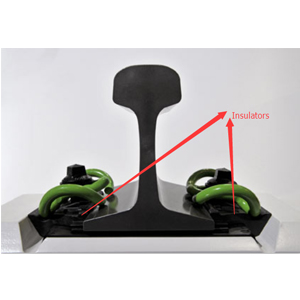Rail Insulator
Why Insulated Rails?
Rails are essential components of rail tracks, guiding trains and transferring wheel pressure to sleepers. They require a continuous, smooth surface with minimal resistance. In electrified railways or automatic block zones, rails also function as signal lines for track circuits and locomotives, necessitating insulation to prevent stray current interference. Insulators and insulated rail joints are typically used in these systems.
Insulators
Insulators provide electrical insulation and protect the ductile iron shoulder from wear caused by direct contact with the rail. They are generally installed between the rail and sole plate, made from Nylon-6 or Nylon-66 (PA66) reinforced with 20%-35% glass fiber. We supply insulators compatible with UIC60, 52kg rail, 136RE rail, 90R, and 75R, available in natural colors or custom options.
| Technical Parameter | Unit | Technical Requirement | Value |
| Density | g/cm | 1.3-1.45 | 1.45 |
| Tensile Strength | Mpa | ≥170 | 178 |
| Elongation | % | ≤4.4 | 4.0 |
| Bending Strength | Mpa | ≥250 | 290 |
| Impact Strength (No gap) | KJ/m2 | ≥80 | 85 |
| Melting Point | ℃ | 250 – 270 | 270 |
| Insulation Resistance | Ω | ≥1×108 | 5×108 |
| Glass Fiber Content | % | 30-35 | 35 |
| Hardness | HRR | ≥110 | 118 |
Types of insulators
E-clip fastening system insulators


SKL rail fastening system insulators (guide plates)




Insulated rail joints

Insulated Rail Joints
Insulated rail joints are crucial for signaling track circuits, compensating for the limitations of ordinary joints. Glued joints, filled with epoxy resin, enhance mechanical strength under stress. They consist of specially designed fishplates, adhesive resin on insulating liners, insulated rods, bolts, and other components, and are particularly effective on long welded rails.
Glued insulated joints can withstand temperature fluctuations and loading forces up to 1000 kN, minimizing gap expansion and ensuring reliable clamping. They also enhance safety, reliability, and durability in various environments.

Challenges and Future Improvements
Despite their advantages, insulated joints face challenges, particularly in heavy loading conditions, where they have the shortest lifespan among railway components. Current inspection methods may not easily detect problems, highlighting the need for improved monitoring solutions.
All our insulated joints are crafted from steel or polymer composites.


